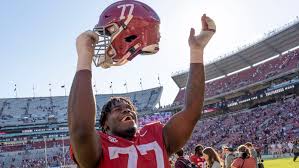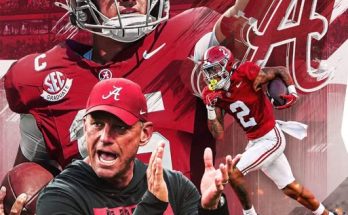The Nick Saban era may be over, but the Crimson Tide’s standard remains sky-high. With Kalen DeBoer now at the helm, Alabama fans are eager to see how the new coaching staff molds the next generation of stars in the trenches. After a 2024 season that showcased flashes of potential but fell short of the College Football Playoff, there’s renewed urgency to solidify the defensive front. For Alabama to return to its place among the elite, the defensive line must evolve from a work-in-progress into a force that can dictate the outcome of games. And that evolution has to start this summer.
Much of Alabama’s offseason buzz has centered on the offensive changes under DeBoer, but internally, the coaching staff knows the foundation of any championship run begins with a disruptive, gap-controlling, and physically dominant defensive line. Over the years, Alabama has built a reputation on smothering front sevens, producing first-round NFL talent like Quinnen Williams, Jonathan Allen, Daron Payne, and Christian Barmore. But since 2021, the defensive line has lacked the same consistent bite—good, yes, but not quite great. That’s what needs to change in 2025.
This summer represents a crucial development period for a group that blends young, hungry underclassmen with seasoned veterans who have yet to fully tap into their potential. There’s optimism that the pieces are there. Now it’s about putting them together.
Alabama’s defensive line last season was solid but not game-changing. At times, it struggled to collapse pockets quickly or win critical third-down battles against elite offensive lines. That lack of disruption showed up in the Tide’s losses and kept the defense on the field longer than it should have been. It’s something the new defensive coordinator—one of the more aggressive tacticians in college football—is determined to fix.
A major focal point this summer will be the development of interior pressure. Edge rushers often steal headlines, but interior dominance can wreck a gameplan. Alabama has seen flashes from sophomore nose tackle Isaiah Hastings, whose combination of strength and leverage makes him a natural candidate for a breakout season. The staff wants him to play lower, faster, and with more command at the point of attack. Behind him, redshirt freshman Jordan Renaud has begun to turn heads. His burst off the ball and ability to penetrate makes him a prime candidate for rotational reps if he can stay healthy and bulk up during summer workouts.
Then there’s the veteran presence of Jah-Marien Latham and Tim Keenan III—both steady contributors with SEC experience, but the challenge now is consistency. Latham has shown the ability to flash dominance in spurts, but the coaching staff is pushing for him to lead with urgency. Keenan, on the other hand, has become a reliable anchor in the middle, especially against the run. Still, there’s a desire to see him convert more pressures into sacks, to be a finisher, not just a disruptor.
The summer strength program will be crucial. Conditioning, explosiveness, and hand technique are points of emphasis. DeBoer and his staff are known for their attention to detail, and that philosophy has carried into the defensive line room, where no rep is wasted. There’s a push to fine-tune technique, especially in getting off blocks faster and improving pursuit angles. Against elite offenses, milliseconds make all the difference.
On the recruiting front, Alabama has done what it always does—stack elite talent. Five-star defensive end Zion Grady is the crown jewel of the 2025 class and has the makings of an instant impact player. Though young, his combination of length, speed, and violent hands has drawn comparisons to former Alabama greats. The staff has no plans to redshirt him if he proves ready in camp. He arrives with expectations, but also the temperament to embrace them.
Alabama also expects sophomore defensive end Edric Hill to take a significant leap. A former top-100 recruit, Hill redshirted in 2023 and saw limited action last season. However, his performance during spring practice drew praise, and he’s added nearly 15 pounds of muscle since arriving in Tuscaloosa. He’s primed to enter the rotation, and if he makes the jump coaches are projecting, Alabama’s depth chart could quickly turn into a true strength.
Another x-factor this summer will be the emergence of redshirt junior Khurtiss Perry. The former in-state star has battled injuries but has reportedly had his best offseason yet. He brings a powerful lower base and explosive first step—qualities Alabama needs in pass-rush situations. If Perry can stay healthy and carve out a niche as a third-down specialist, he could be a difference-maker when the lights come on this fall.
Still, the success of the defensive line won’t be judged on individual breakout seasons alone. Alabama needs to dominate as a unit. That means executing stunts, maintaining gap integrity, and holding firm on third-and-short situations that have plagued the team in recent years. This summer, the defense is focused on culture as much as performance. There’s a daily emphasis on communication, unity, and doing your job—the principles that defined the best Crimson Tide defenses of the past.
The new staff’s messaging has been consistent: No more relying on potential. It’s time to produce. They believe this defensive line group can be special—but only if it embraces the grind now. The leadership of returning veterans is being tested. Younger players are being thrown into live reps and asked to learn quickly. And across the board, there’s urgency to return to the standard Alabama built its dynasty on—domination in the trenches.
The SEC isn’t getting any easier. LSU, Georgia, and Texas all boast loaded offensive lines and explosive run games. If Alabama wants to regain its spot atop the conference, it needs to win battles at the line of scrimmage. That starts with the defensive line. Too many recent matchups have been defined by Alabama failing to create pressure in key moments. That’s not just a schematic issue—it’s a toughness issue. A readiness issue. And that’s what this summer is about fixing.
One of the unspoken aspects of Alabama’s historical dominance has been its ability to rotate fresh legs across the line without any drop in intensity or execution. That depth was missing at times last season. This summer’s mission is to rebuild that depth—not just in numbers, but in trust. Players must prove they can handle assignments, execute at game speed, and deliver in crunch time. If that happens, Alabama’s front line could go from a question mark to one of its biggest strengths.



